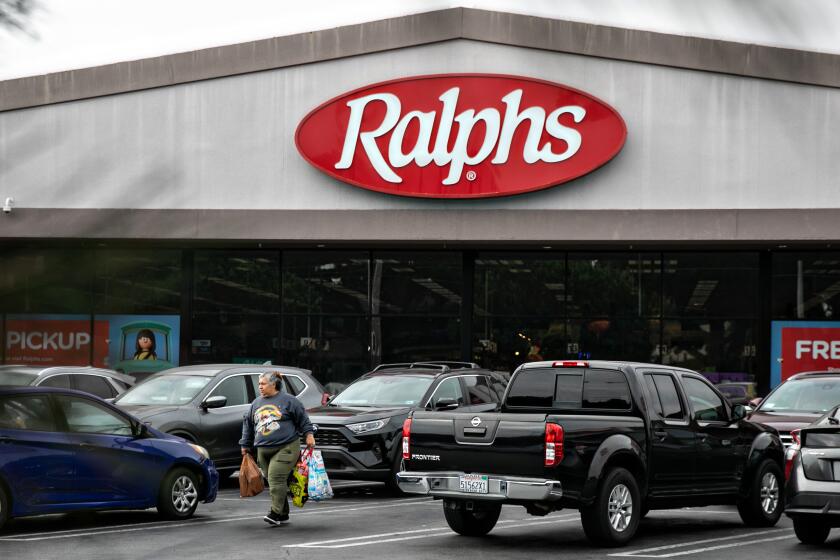Ralphs, Hughes Market Chains Plan Merger
- Share via
In the latest in a wave of Southern California supermarket mergers, Ralphs Grocery Co. said Thursday it will be combined with Hughes Family Markets in a two-part transaction that would extend Ralphs’ lead as the region’s largest supermarket chain.
If federal and state regulators approve the deal, Hughes stores would be converted to Ralphs. While no store closings are planned, Ralphs plans to cut costs and pass those savings on to consumers, said Ron Burkle, chairman of the Yucaipa Cos., the Los Angeles-based firm that owns Ralphs.
The deal would boost the market share of Compton-based Ralphs, which includes the Food 4 Less chain, to 32% in the five-county Southern California region, up from 28%. That would give it a larger lead over Arcadia-based Vons, at 21%, and Dublin, Calif.-based Lucky Stores, with 18%.
The transaction also would be another coup for Burkle, who became a major player in the supermarket industry when Yucaipa acquired Ralphs in June 1995. Yucaipa controlled the Alpha Beta, Boys and Viva chains, which were converted into Ralphs or Food 4 Less stores.
The proposed union joins a trend of supermarket consolidations that has reduced the number of locally owned chains. Pleasanton, Calif.-based Safeway Inc. acquired Vons in December 1996. Seattle-based Quality Food Centers--known as QFC--acquired Hughes in November 1996. Austin-based Whole Foods Market bought Mrs. Gooch’s in 1993.
“This will become a national trend because size is important,” said one industry analyst. Vons, for example, is stronger and more competitive since it was acquired by Safeway, said the analyst, who asked not to be identified.
Chains in Southern California and other parts of the country have been seeking merger partners to boost their ability to negotiate lower prices from suppliers.
In addition, chains can cut costs through mergers. For example, by eliminating the Hughes nameplate, Ralphs could eliminate the Hughes advertising budget and get more bang for its buck because it would be operating more stores.
Burkle said Hughes’ warehouse and headquarters in Irwindale would face cost cutting, with the warehouse to be closed and distribution operations to be shifted to a Ralphs facility. The jobs of about 100 of Hughes’ 5,000 employees may be at risk, Burkle said.
“We intend to take the cost savings and pursue a larger share of the market,” Burkle said.
Critics of such mergers say they will eventually lead to higher prices as competition is diminished. However, analysts say, prices so far have stayed about the same following recent mergers.
The deal must be approved by the Federal Trade Commission and the California attorney general. Either could block the deal on antitrust grounds, or force the companies to sell some stores as a condition for approval.
Ralphs has 27,000 employees and operates 262 Ralphs stores and 80 Food 4 Less discount warehouse stores in Southern California. Hughes has 57 stores.
The planned Ralphs-Hughes combination is part of a two-part, $4.8-billion transaction that would consolidate four supermarket operations. Ralphs would be acquired by Portland, Ore.-based Fred Meyer Inc. but the Ralphs and Food 4 Less chains would retain their identity and format. Fred Meyer would also acquire QFC, the grocery company that acquired Hughes last year. In return for transferring Ralphs to Fred Meyer, Yucaipa would gain 10% ownership of Fred Meyer.
Under the agreement announced Thursday, Burkle would become the chairman of the combined company, to be under the Fred Meyer name. Burkle became chairman of Fred Meyer in May when he engineered the merger of Meyer and Utah-based Smith Food & Drug Centers. Burkle’s Yucaipa owned 24% of Smith Food & Drug before it was merged with Meyer.
The companies would be combined under a stock swap. Fred Meyer’s acquisition of QFC would cost $1.7 billion--the value of QFC’s stock and debt. Meyer would acquire the stock and debt of Ralphs for $3.1 billion. Meyer’s current stock and assets are valued at about $5 billion.
The deal would create a company with 818 stores in 14 states and annual sales of $15 billion. It would vault the 10th-ranked Meyer and the 11th-ranked Ralphs to the No. 4 position among supermarket chains nationally, behind Kroger, Safeway and American Stores.
Burkle said there would be annual savings of $100 million from the Ralphs-Meyer-QFC-Hughes deal.
The proposed merger must be approved by the shareholders of Fred Meyer and QFC. The principal shareholders at both companies support the deal. Among the supporters is Sam Zell, a Chicago-based investor who owns about 20% of QFC. Zell and Burkle were involved in the negotiations that led to the merger.
Ralphs agreed not to acquire any additional chains for five years as a condition for regulatory approval of its merger with Food 4 Less Supermarkets, the company that controlled the Alpha Beta, Boys and Viva chains.
However, Burkle said Fred Meyer--not Ralphs--would actually acquire Hughes. The Hughes chains would then be converted to a Ralphs store chain that would be controlled by Fred Meyer, he said.
“We’ll be having discussions with the state attorney general about the plan,” Burkle said.
Under the deal, Ralphs President George Golleher would oversee the Ralphs and Hughes stores.
More to Read
Inside the business of entertainment
The Wide Shot brings you news, analysis and insights on everything from streaming wars to production — and what it all means for the future.
You may occasionally receive promotional content from the Los Angeles Times.










